PRESERVING A MILITARY LEGACY FOR FUTURE GENERATIONS
The following Reflections represents SGT John Graham’s legacy of his military service from 1962 to 1966. If you are a Veteran, consider preserving a record of your own military service, including your memories and photographs, on Togetherweserved.com (TWS), the leading archive of living military history. The following Service Reflections is an easy-to-complete self-interview, located on your TWS Military Service Page, which enables you to remember key people and events from your military service and the impact they made on your life. Start recording your own Military Memories HERE.
Please describe who or what influenced your decision to join the Marine Corps.
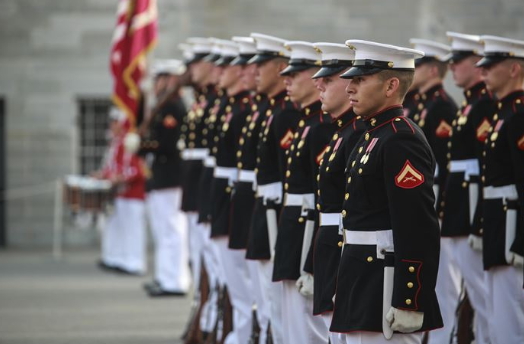
I was at a decision point after graduating from High School. My dad had convinced me that I needed a college degree, so I had taken the entrance exams and signed up to attend East Texas College. I realized that my family did not really have the financial means to pay for my college tuition. A couple of my friends joined the Marines at the end of summer, and that hit me as a good solution. I could go to the service first and attend college later. This was a great relief for me to remove the college expense from my family.
Whether you were in the service for several years or as a career, please describe the direction or path you took. What was your reason for leaving?
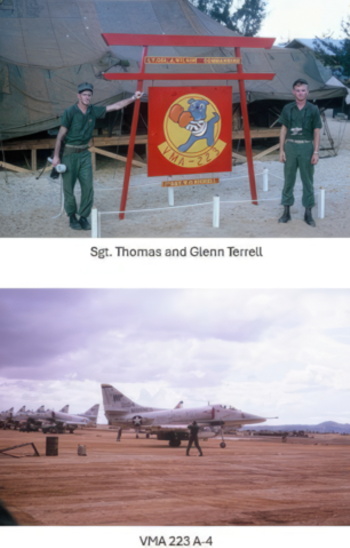
I joined for a four-year term. I was assured of entering the Marine Air Wing after boot camp at San Diego and ITR at Camp Pendleton. I attended Avionics Comm/NAV School in Memphis, TN. After graduating from avionics school, I was able to choose to join one of my friends I enlisted with at El Toro MCAS in Orange County, CA. My friend, Glenn Terrell, arranged for me to join VMA223, which was an A-4 airplane squadron nicknamed the “Bull Dogs.” In August 1965, we were deployed overseas to Iwakuni, Japan, and our squadron went over the Pacific Ocean on a Flat Top with our A-4s on the Navy ship Valley Forge. At that time, about six A-4 squadrons rotated between Iwakuni, Japan, and Chu Lai, Vietnam, with four squadrons based at Chu Lai at any given time. In early November, I was transferred to VMA214, another A-4 squadron with the nickname the “Black Sheep.” I had stints at Iwakuni, Japan, Chu Lai, Vietnam, and a brief time on a six-plane deployment at Subic Bay Naval Air Station Philippines; I was due to get out at the end of September 1966. A meeting was had with our squadron commanding officer about re-enlistment. I had good marks and had been promoted to Sgt. E-5 earlier that year and was asked to re-enlist. But I convinced the Lt. Col. I was convicted to attend college, study accounting, and get a business degree. The colonel agreed and granted me two weeks early out to attend school in the semester starting in September. On August 28, I was on the way via Chu Lai. Da Nang, Okinawa, El Toro. Love Field Dallas.
If you participated in any military operations, including combat, humanitarian and peacekeeping operations, please describe those which made a lasting impact on you and, if life-changing, in what way?
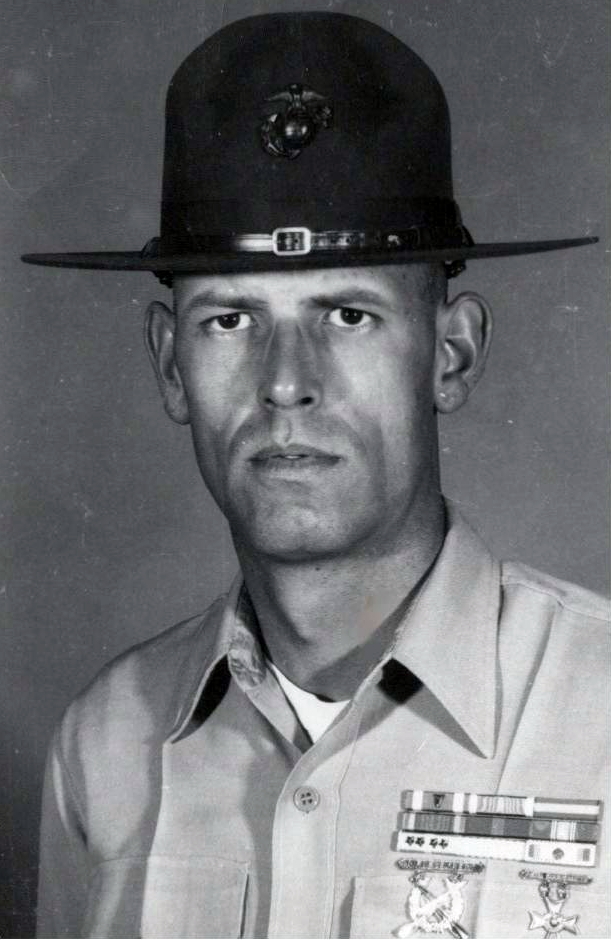
MY BOOT CAMP EXPERIENCE
Considering boot camp as a military operation, my boot camp experience was extended due to an injury. After the first three weeks in San Diego, our Platoon headed to Camp Matthews for several weeks of rifle range training and qualifying. On the first day of the second week, early in the morning before light, I broke my ankle, stumbling and twisting in the workout logs used for team exercises. I had my combat boots on, which allowed me to walk but could not “snap in” while practicing the kneeling rifle position. One of the drill instructors sent me to sick bay. In short order, it was determined that I had broken my ankle, and I was then loaded into a Marine version of an ambulance. Oddly enough, another Marine broke his ankle that same morning. He was a Corporal E4 rifle range instructor. Unfortunately, I do not remember his name. While on the way to the Balboa Naval Hospital in San Diego, we struck up a conversation and got to know each other pretty well on the long drive to the hospital. I was very surprised that he talked to me without yelling like all NCOs in boot camp. In fact, we became more like friends, and all former “boots” know how unusual that sounds. We both received full leg casts without a walker and had to use crutches. We were both in a hospital bay with several other hospital beds. Over the next week through Sunday, the Corporal and I got to know each other quite well. We ate meals together and hung out.
The following Monday, I was released from the hospital, transported to MCRD, and reported to the regimental casual unit, where all the Marines who were injured and had to leave their Platoon were assigned. We marched to chow hall together three times a day, even those of us on crutches, and were assigned light-duty work details. During this time, people such as myself, who are going to be out of a platoon for months, go to classroom activities that all Marines have to go to several times a week until they graduate. After completing those classes, a recruit then goes to battalion casual. Therefore, I was assigned to the 2nd Battalion casual unit. Our unit was housed on the second floor of the 2nd Battalion Headquarters. I was assigned to be the 2nd Battalion routing clerk. I maintained a log and assigned recruits moving from one unit to another for reasons such as going to and from casualty units and other routine re-assignments. In the week just before Christmas, the Platoon that I was originally in graduated and was going home on holiday leave before attending ITR at Camp Pendelton, which was normally where they would go immediately after boot camp. On my way to the chow hall in late December, I saw my former platoon buddies, including two of my best friends, boarding the buses to travel home for Christmas. This was a gut punch, as I was one homesick 18-year-old guy.

During my duties in the 2nd Battalion Headquarters, on occasion, Gunnery Sgt Pichler, who was my Platoon commander, would come through the office and normally acknowledge me with a nod. About the third week of March 1963, Sgt Pichler came through Battalion Headquarters, headed directly to my desk, and asked me if I was fit to join his current Platoon that was going to the rifle range in a week or two. I told him that I was walking but still limping. He asked me if I could pass the PT test, which was necessary to join a new platoon. My answer was that I thought that I would not get many points for the run but could do well on all the other tests. At that time, the PT test consisted of pull-ups, sit-ups, push-ups, and a 300-yard run. Sgt. Pichler indicated that he would talk to medical and set up a visit to the doctor and arrange for the PT test. If I could pass, he would see to it that I had time to recover before I needed to march in formation fully. I was extremely grateful to Sgt. Because of his extraordinary action and this opportunity, Pichler probably saved me from spending an additional month or two in boot camp as Sgt. Pichler indicated a doctor’s appointment had been set up, and I had been released for duty. I reported to take my PT fitness test and got zero points on the 300-yd run but scored enough on the other sections to pass the test and be released to go back to Sgt. Pichler’s Platoon.
By the way, at the rifle range, there are two weeks of “snapping in” to prepare to fire the rifle. The third and final week is actually spent on the range practicing for the qualification test on the 5th day of that week. Surprisingly, the Corporal I met and became friends with about 6 months earlier at the hospital was my rifle range instructor. I have always considered that to be one of the great coincidences in my life.
A CHU LAI VIETNAM EXPERIENCE
While in Chu Lai sometime in early 1966, during night operations, one of our planes clipped the A-4 landing gear upon attempting to land on the aluminum metal runway and had to re-establish flight by hitting full throttle. He then had to circle over Chu Lai and the South China Sea to burn off the jet fuel before “punching out” of the damaged plane. The aircraft crashed in a sandy area that was within the outside perimeter of the Chu Lai established control area in a deserted part of the airbase. The pilot was safe and thankful his parachute functioned properly as he landed in the sea very close to the base. I was part of a crew of about six guys to ride in a jeep to the plane in order to get sensitive avionics and ordinance gear out of the plane (such as ECM, TACAN, UHF, GCBS, and the Gyro navigation system). It was not that dangerous but was interesting to a Marine avionic wing-wiper.
Did you encounter any situation during your military service when you believed there was a possibility you might not survive? If so, please describe what happened and what was the outcome.

In November 1965, my friend Richard Varney and I were transferred from VMA223 (Bulldogs) to VMA214 (Black Sheep) in a seniority balancing maneuver in order to equalize the avionics departments in the six A4 attack aircraft squadrons in Chu Lai and Iwakuni, Japan. On November 9th or so, we landed in Chu Lai, Vietnam, on a C-130 transport plane, and I will never forget the feeling and visual effects of Chu Lai: aluminum runways, tents everywhere, including the avionics shop, living quarters, mess hall, and then of course all of the sand. There were mountains to the West, the South China Sea to the east, and smoke trails in the sky. Then there were the visuals and smells of the outhouses burning waste materials daily. Chu Lai’s flight line consisted of four squadrons of Skyhawk birds, with each squadron operating over twenty aircraft. The length of the flightline would be several hundred yards.
On the second or third day, we stood a Marine Corps birthday parade in the sand, with temperatures well over 100 degrees. We were standing at attention or parade rest in full 782 gear, meaning combat boots, hard hat, full utility belt, and M14 rifle. I felt fortunate that I didn’t faint face first into the hot sand while standing at parade rest.
About one week before our arrival, the Viet Cong had infiltrated Chu Lai with about seven Cong bad guys running down the flightline, firing grease-gun automatic weapons and tossing satchel charges into the A4 aircraft engine air-intakes. Although most of the satchel charges were duds, some exploded, resulting in the loss of several of the A4 Skyhawk airplanes. My new squadron lost two birds and was hit hard because they were located on the far north end of the flight line. The A4s were located such that every two planes were separated by 55-gallon metal drums filled with sand and pyramided about three barrels high to guard against one plane explosion, taking down the whole flightline of over 80 aircraft. The flightline at night was patrolled and guarded by Marines with sawed-off 12-gauge shotguns. The scatterguns were designed to cause massive human stopping power while causing less potential damage to the airplanes. All seven of the bad guys were blown to smithereens, and none of the Juggies were even injured. Of course, Varney and I had not witnessed the attack but heard all about it from our new fellow Black Sheep squadron mates. Also, there were very graphic photos on the mess tents bulletin board showing the seven Vietcong bad guys after they had been neutralized permanently. An interesting story also was told of one of the Marine guards toting a sawed-off shotgun that sighted down a Cong and pulled the trigger on the flightline, but the weapon misfired. As the story goes, he ducked around the barrel revetment to pump a new shotgun shell into the breach, but the Cong threw a satchel charge at his feet. Luckily, it was a dud. The death dance lasted, per the lore, at least one more round of misfire and dud until the Marine’s shotgun literally shot the Cong in-two with a thunderous close-range blast. The photos were right there on the mess hall bulletin board for several weeks. Needless to say, we Juggies, especially new guys in country like Varney and I, were expecting this kind of trouble the rest of our time in Vietnam.

Our squadron had a scheduled afternoon on the beach with actual steaks cooked on grills, including all the trimmings, like baked potatoes and beer. About once during the squadron’s four or five months rotation to Chu Lai, we had a “raise morale” afternoon on the sandy beaches of the South China Sea with virtually all the officers and enlisted men enjoying themselves swimming and having a great time. Everyone had been tossing each other into the South China Sea, throwing footballs around, and having a good old time. I believe many or most of our guys had enough or too much to drink in order to let go of as much stress as possible, except for a lance corporal from Louisiana (Bubba) and me. We were on the night shift, and the entire avionics team was relieved of duty that night except us. The two of us had started installing an electronic relay in the front wheel well of one of our birds earlier that afternoon and had to return to the flight line after the festivities to finish the job. The plane needed to fly the next day, as was explained very plainly to us by our Maintenance officer. So, after the party was about over, we gathered our stuff, rifle, hard hat, etc., and headed back to the flightline. The job was going to take about four or five hours of intense soldering wires, installing the relay, and then checking out the operations of the repaired system. Bubba and I worked a lot together. He was younger, and I was in my last year. I had about two and a half years of avionics experience and was detailed to train him. We generally worked very well together. Since our squadron was basically shut down that evening, we were just about the only guys working on our birds. Just a few planes to the South, the squadron next to us was running night operations, including the “hot pad” to cover emergency close air support to the Marine grunts on the ground needing help. With jet airplanes firing up in such close proximity, it was kind of noisy. Well, we had been working on that relay for several hours, and the time was about 10 or 11 p.m. There had been considerable activity just down the flight line from us, with planes going out on their night close-air support missions. Suddenly, a horrifying explosion within about 20 yards of us shook us mightily in our boots.
We saw two of the airplanes just to the South of us burning, and we could hear automatic gunfire at the source of the explosion. Within a minute or two, an extremely loud warning alert siren started a shrill, loud, constant, terrifying sound. Obviously, we envisioned Vietcong running down our flight line, pitching satchel charges down the intakes of the birds, and firing machine grease guns at us. Our hard hats and rifles were in the avionics shop tent, so we hot-footed over there, and I can remember grabbing my rifle and hard hat and jumping on a chair to unscrew the lightbulb in our shop. All the while, Bubba and I were heading into the foxhole just in front of the shop tent. I thought we both got there about the same time. A few beats later, I got my rifle locked and loaded.

I heard someone running up behind us from the South. I thought for sure it was a Cong charging us with one of their satchel charges or automatic weapons. I turned to my back left, finger on the trigger, and ready to blow that bad guy away. Just at the exact same moment, I realized that the bad guy was actually Bubba. To this day, I don’t know why he was several seconds later than I was to the foxhole and why he came from the back left, but I was so relieved that I did not blow a hole through him with my M14. I am convinced that it was by the grace of God that I didn’t. I often think how hard it would have been to live my life with such a horrible accident. I thank God constantly for this blessing. As for Bubba, I patted him on the back and told him it was about time he joined the party. A short time elapsed, maybe five minutes, and a jeep came rolling down the flight line shouting all clear. The explosion was only an accident, not a Cong attack.
We found out what happened the next day. The two “hot pad” airplanes were started up with the pilots on board and about to go on a mission with the ground crew still around them about to wave them away for takeoff. A fuel truck came rumbling down the flight line directly in front of the fired-up jets, but the truck’s fuel line nozzle was not attached and just bouncing around, squirting jet fuel as it rolled along. When the fuel truck got close to the jets, the fuel was sucked down one of the intakes. The explosion caused both of the birds to become huge fires, which also consumed an electrical supply vehicle and a jet start-up pod connected close by the warbirds, which were fully loaded with close air support armory, including 20 mm Cannons on each plane. Miraculously, both pilots got out of the plane without life-threatening injuries. I did not see official reports, but the scuttlebutt reported that one of the pilots broke both of his legs getting out of the cockpit while somehow leaving both of his flight boots jammed behind the rudder pedals. Oh yeah, the automatic gunfire was actually the 20 mm Cannons cooking off their rounds. Who would know they would sound just like the grease gun 45 caliber automatic weapons that the Cong were known to use?
So, except for scaring the heck out of a bunch of “wing wiper” Marines, losing a couple of A4 Skyhawks ground equipment, and injuring two pilots who were part of the greatest military pilots known, everything came out better than we could have expected. Of course, my take is another grace of God thing.
Of all your duty stations or assignments, which one do you have fondest memories of and why? Which was your least favorite?

It is hard to choose a favorite between El Toro and Iwakuni, Japan. Both were fantastically enjoyable and very interesting places. Obviously, Vietnam was my least favorite because it was in a hostile land. However, it was very memorable because of some of the items mentioned previously, plus the Bob Hope Christmas show in December 1965, a full-day tour of the huge Da Nang base, which included the Vietnam people living on the base, and the feeling of helping to protect our democracy from communism which was the thought that government officials were telling us in the military.
From your entire military service, describe any memories you still reflect back on to this day.
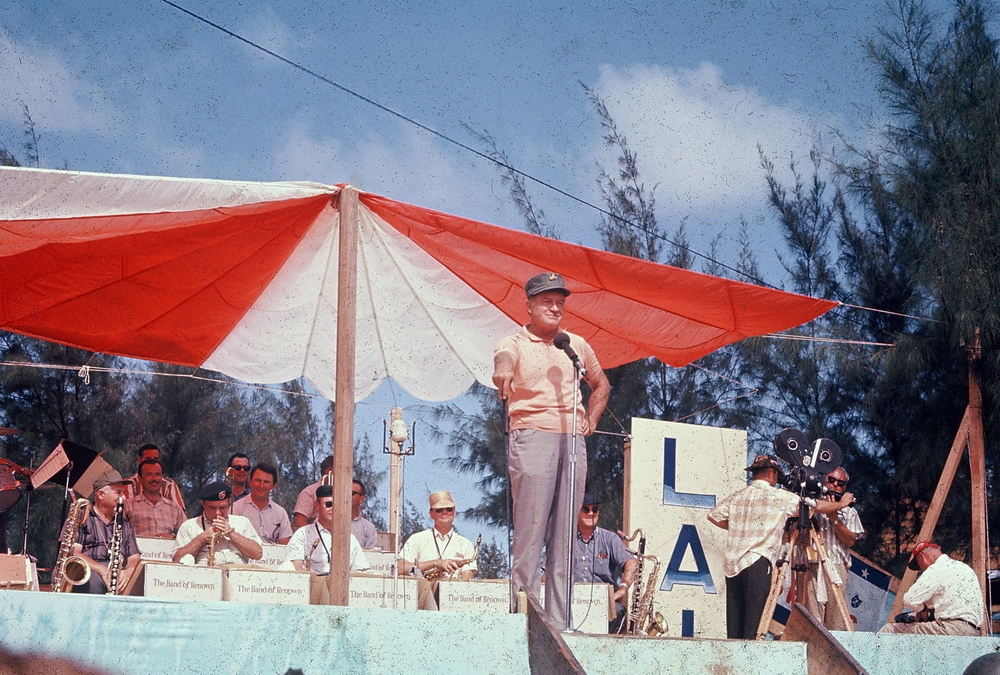
I reflect on my military experience frequently, recounting certain events to my wife and mostly other family members. I feel like I got a lot from being in the service.
In Chu Lai in 1965, during the late Christmas season, around December 23, I had the opportunity to attend the USO Bob Hope Christmas Show. What a wonderful experience. About a hundred yards or so from my tent was a huge bowl-like area of sand. At this location, USO shows were regularly performed with stars such as Martha Raye and Eddie Fisher. But this Christmas program was absolutely a lifetime experience. Bob Hope was joined by Hollywood greats, including Anita Bryant, Carol Baker, Joey Heatherton, Jack Jones, and Les Brown and His Band of Renown. I can’t fully explain my full appreciation. I don’t know the count, but hundreds, if not thousands, of military guys were there. Let me tell you, there was hardly a dry eye in the whole bunch as we all sang “Silent Night” at the end of the show.
During my several years at El Toro in VMA 223, the following are some brief remembrances of those years:
In late 1964 or early 1965, VMA 223 lost a pilot and plane in a normal training flight exercise. This pilot was one of our senior pilots, as I recall, and a captain who was also the maintenance officer, I think. The feeling of losing a fine Marine aviator, who was a family man, was difficult for our entire squadron.

In 1964 and 1965, VMA 223 did a couple of deployments to the Naval Air Station in Yuma, AZ. It was hot, but the barracks had individual rooms for a couple of guys, plus the mess hall was excellent at this ex-Air Force facility. Upon the return to El Toro from one of the deployments, we found that our hanger was being used as a morgue. In June 1965, an Air Force C-135 with 72 Marines and 12 crew members took off from El Toro and crashed in a nearby mountain. As I recall, we helped remove some of the items from the crash from the hangar before starting our normal activities.
In February 1965, VMA 23 sent a contingent of our A-4 Skyhawks to operate off the Naval Carrier USS Yorktown. My friend Glenn Terrell, out of our avionics shop, was a part of the support guys on that deployment. The USS Yorktown entered the Vietnam War on February 24, 1965, even before the war actually started. The air attack was centered at the Gulf of Tonkin. Glenn had some great stories to tell from his brief time on the ship. I was jealous of his experience, especially when the first “Top Gun” movie was released.
Also in 1965, VMA 223 traveled to the Whidbey Island Naval Air Station and operated out of an unused hanger next to a squadron of Navy A-3 Skywarriors. On that trip, I didn’t get a chance to visit nearby Seattle, but a couple of memorable things happened. One morning, I woke up and found a Moose head in the bunk next to me. We discovered that a fellow Marine from Canada brought it home from a local bar. Well, I believe Mel (can’t remember his last name) was counseled and had to return his trophy. Also, somehow, a 250 lb. dummy bomb with beautiful paintings and markings from a shop in the A-3 squadron next door made its way with us and hung in our avionics shop back in El Toro. I won’t go into any other details.
During my overseas stint in Iwakuni, we took some planes and support crew to Subic Bay in the Philippines. We all got introduced to “San Magoo” beer in Olongapo, as well as barbequed monkey meat on a stick. We worked hard and played hard on that deployment. Tragically, a bad memory also occurred. On night operations during A-4 ocean target drills, we lost a pilot and a plane. The plane and debris items that were recovered were difficult, especially a partial flight boot that was found. Also, while we were in Subic Bay, the USS Enterprise nuclear carrier was docked about 100 to 200 yards away from our flight line. What a magnificent and beautiful sight that US warship was.
What professional achievements are you most proud of from your military career?

I used the service as a tool while I was in college, working in avionics at LTV. I used the GI bill to help pay for my education, both BA and master’s degrees.
While working at LTV on refurbished F-8 airplanes headed to Vietnam in early 1968, I was asked to go to Miramar MCAS in San Diego to check out ECM system installations. I drove with my wife to this assignment. On the way, I nearly ran off the highway when we came around a mountain in the outskirts of El Paso and immediately saw in front of us a huge Marine recruiting billboard with a full photo of my friend Larry Werchan in his boot camp dress blues. This was another great coincidence in my life. Also, while on this trip, my wife and I decided I would volunteer to work nights so that I could attend college during the day for both regular sessions and summer sessions in order to finish my degree earlier.
Of all the medals, awards, formal presentations and qualification badges you received, or other memorabilia, which one is the most meaningful to you and why?
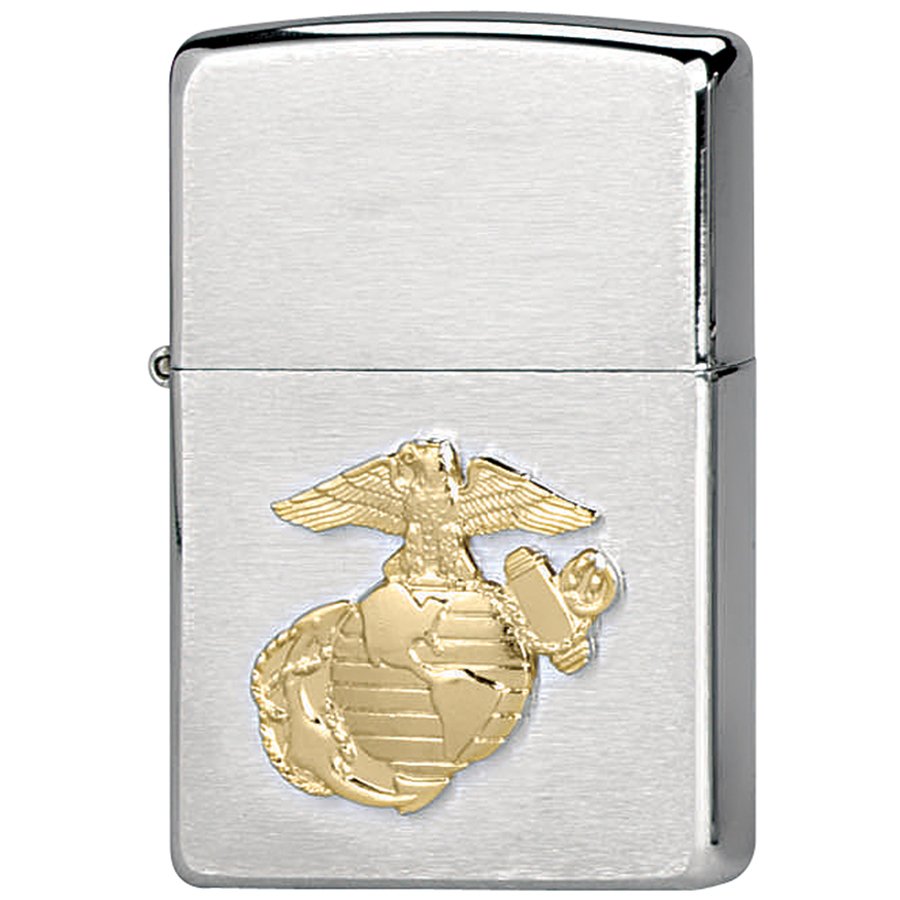
Being in the service for four years, my medals only consist of a Good Conduct Medal and Vietnam service-related medals. I have two memorabilia items that I appreciate. One of them is an “Eisenhower battle jacket” issued to me in boot camp and a Zippo Marine Corp cigarette lighter with my name engraved on it that I got in Memphis while in school. I still have the lighter, although I quit smoking over 50 years ago.
Which individual(s) from your time in the military stand out as having the most positive impact on you and why?

Gunnery Sergeant Louis Pichler from boot camp had a huge impact on me. I was in his Platoon twice because of an injury. The “why” is a very long story that has been explained earlier, but he sought me out and allowed me to return to active duty before I was even able to walk without a limp.
There was another Gunnery Sergeant who was over our avionics shop in El Toro. Unfortunately, I cannot remember his name. He was very instrumental in convincing me that I could be an extraordinary avionics flight-line technician. Gunny also gave me a great piece of advice when I was concerned about losing some of our experienced avionics guys because of their discharge. Gunny explained to me that no one is indispensable, and the test for that was to have a person put their hand in a bucket of water, and if they don’t leave a hole when they pull it out, they are not indispensable. Gunny also said that there was only one person who could ever have passed that test, and that person was Jesus Christ. WOW, what an impact that had on me.
The professional Marine aviators that I worked with, particularly in Vietnam, were gung-ho all the way. The best aviators in the world were committed and loved to fly sorties to help the fighting Marines in the battle.
List the names of old friends you served with, at which locations, and recount what you remember most about them. Indicate those you are already in touch with and those you would like to make contact with.
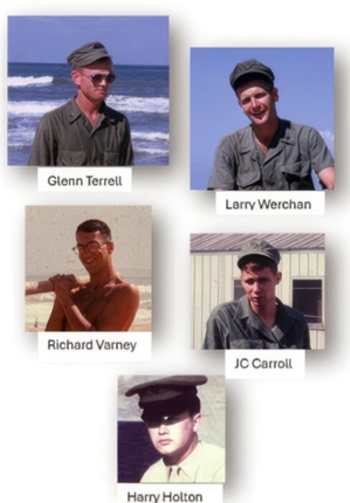
Glenn Terrell. I joined the Marines with him, we were stationed together in boot camp until I was injured, we were in Memphis in avionics training until he graduated several months before me, and we were at El Toro and Iwakuni, Japan, until I was transferred to VMA214. We worked together for a while at LTV and met at times with other friends. We were in contact shortly before his death in June 2019.
Larry Werchan. We met in Battalion Casual in boot camp, we were together in VMA223, and we saw each other regularly at Chu Lai because we both worked nights on the flight lines of our respective squadrons. We contacted each other several times in person and quite a few times via electronic communications. Larry died in December 2021.
Harry Holton. We met at El Toro and were together in VMA223. Harry was a career Marine and had been a leader in our avionic shop. We were together until I left VMA223. We are in contact several times a year. Harry is living in the Long Beach area of California. I really enjoy visiting with Harry on the phone or electronically. Next time in California we will meet up.
Richard Varney. Varney was a good friend in VMA223, and we were transferred together to VMA214 in Vietnam. Varney was several years older than me, but we had about the same time in service. He was married, mature, and studious. I was impressed by his mature actions overseas. Two things about Varney stand out to me: he wasn’t interested in drinking and having a good time at the bars, and Varney suggested a trip to the Iwakuni library where I checked out the “Occupational Handbook Guide” book, which led me to choose accounting as my major in college. We have been in contact several times. Varney is living in the Seattle area.
James (JC.) Carroll. J.C. was a good friend from the Oklahoma City area. He was a Studebaker lover and had an old Studebaker (I believe a Starliner) that he was restoring at his uncle’s house near El Toro. I helped him a few weekends. He came to Dallas a few times, and we went to Midwest City in Oklahoma to visit him. JC had a medical issue that caused him to lose all the hair on his body, and I believe he died in the 1990s at an early age.
A regret I have is I did not reach out to contact Sergeant Pichler as a Marine or later in life to let him know how appreciative I was of his compassion and helping me get through boot camp after my broken ankle injury. I learned a few years ago that Louis Pichler died in 2013. He was a retired Sgt. Major and had served 36 years of active duty with the USMC.
Can you recount a particular incident from your service which may or may not have been funny at the time but still makes you laugh?
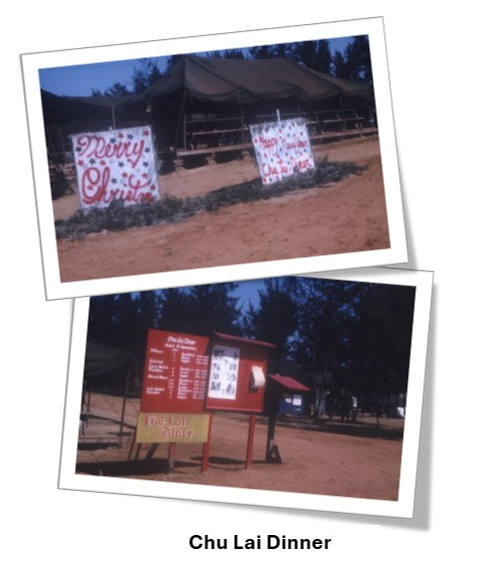
The Chu Lai dinner was known for its culinary creations using Spam: chicken fried, Spam, C-ration cheese, and Spam with powdered eggs. To this day, I can’t stand to think about Spam. Interestingly, while in Iwakuni, a couple of friends and I took a day trip to the large city of Hiroshima to visit the Peace Museum. We took the train there and went downtown, where we stopped at a nice restaurant. I ordered what they called a “Hamburg Sandwich.” I was thrilled at the thought of having a hamburger after such a long time. To my surprise, the “Hamburg Sandwich” turned out to be a Spam sandwich that went untouched. The Peace Museum was a very historical and sobering thing to see, with artifacts from the atomic bomb and the destruction of the city. The Atomic Dome, a standing skeleton of a building remaining after the bombing, is still there.
I was also involved in the Orange County State College – Fullerton Elephant races in 1964 or 1965, where a number of El Toro Marines from all the units of approximately 40 men combined were bused to the campus of that university and served as crowd control. All of us Marines were also invited to a festive hootenanny and barbeque cookout with music, dancing, and mingling along with many students.
What profession did you follow after your military service, and what are you doing now? If you are currently serving, what is your present occupational specialty?

I went to college, received a BA in Accounting, and upon graduation in August 1971, was employed with a Big 8 CPA firm, Haskins & Sells, in Dallas, Texas. One of the audit clients was a large regional real estate firm, and I spent the next nine years with them, going from staff account to Senior Vice President. Chief Financial Officer. During my last three years with the real estate firm, I attended night school to receive a master’s degree in real estate finance. I continued in commercial real estate finance until I retired in 2017. In retirement, we travel and volunteer at our church.
What military associations are you a member of, if any? What specific benefits do you derive from your memberships?

No, other than TWS. I am the recipient of medical care at the VA Medical Center, mostly because of Vietnam-related issues.
In what ways has serving in the military influenced the way you have approached your life and your career? What do you miss most about your time in the service?

I was in for a short time but consider the time spent extremely valuable. My service allowed me time to mature and determine a path forward. I gained a skill that enabled me to make a living and raise my family while completing my GI Bill degree.
Based on your own experiences, what advice would you give to those who have recently joined the Marine Corps?
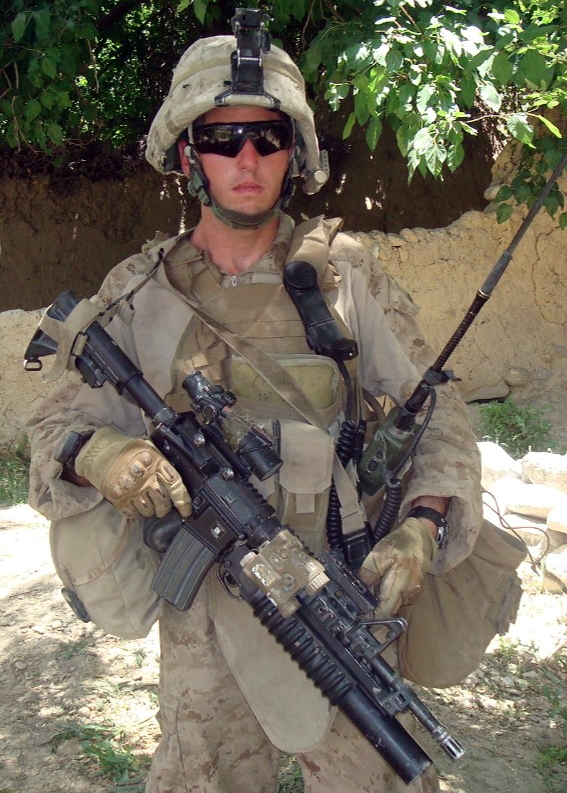
I have and will continue to pass along advice given to me when I joined. My brother-in-law, a former Marine, told me to remember that many thousands of men had gone through boot camp before me and survived and that I could do it, too. That was good advice. I passed this advice along to my nephew, Zephan Cannon, and others.
In what ways has togetherweserved.com helped you remember your military service and the friends you served with.
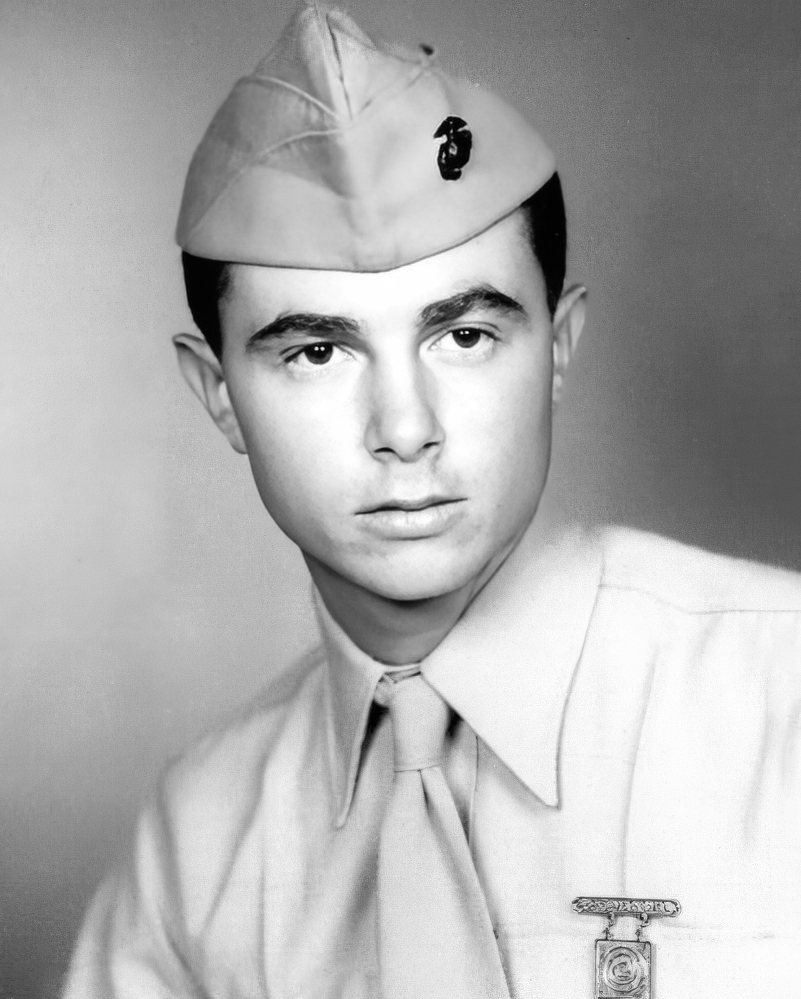
I remember my time in the service clearly and have talked about it a number of times to my wife and others. However, completing this questionnaire for TWS has allowed me to memorialize some of my experiences in a way that I can share with my grown children, granddaughter, the sons of my brother-in-law, and my entire extended family.
PRESERVE YOUR OWN SERVICE MEMORIES!
Boot Camp, Units, Combat Operations
Join Togetherweserved.com to Create a Legacy of Your Service
U.S. Marine Corps, U.S. Navy, U.S. Air Force, U.S. Army, U.S. Coast Guard
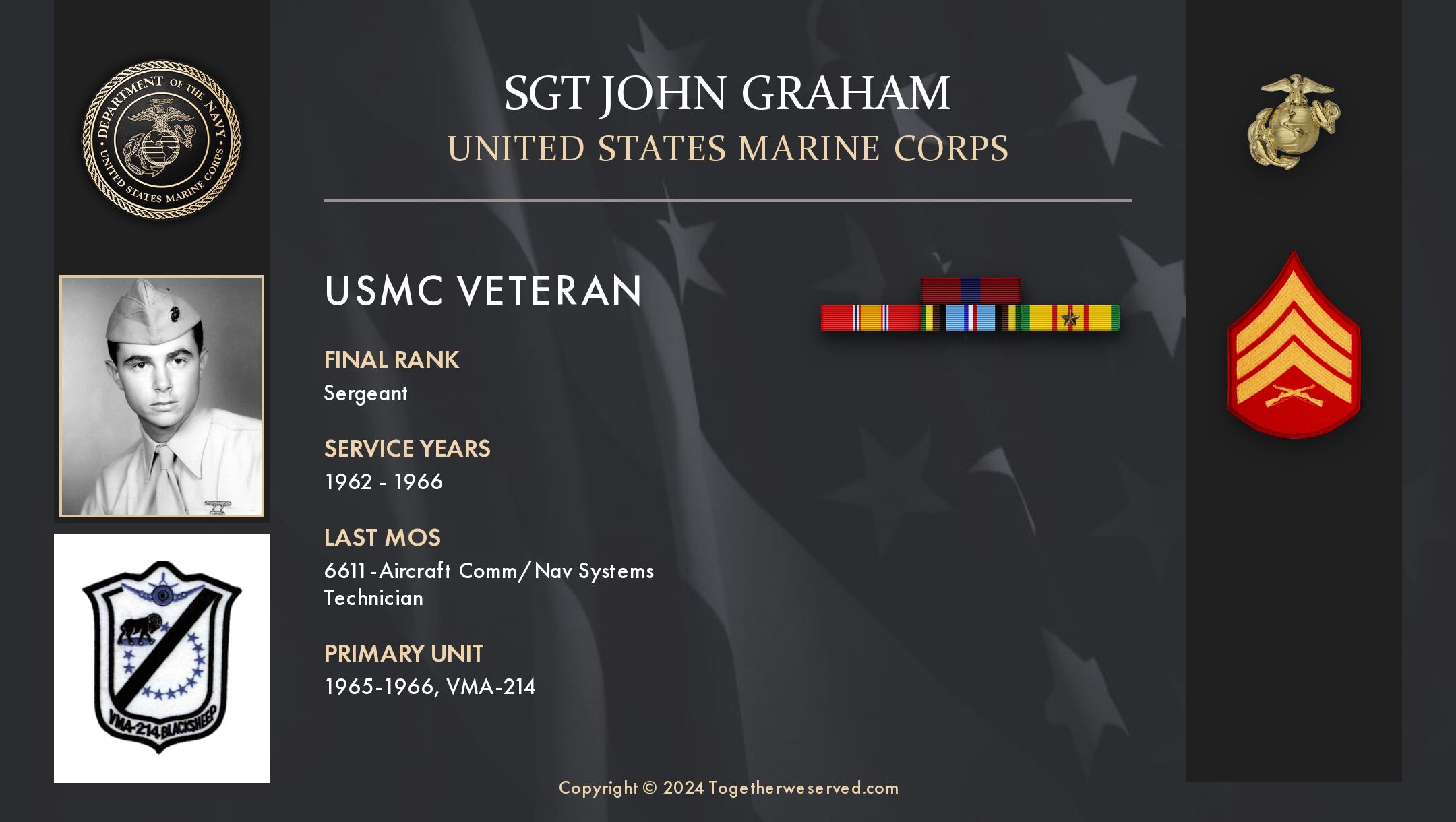
0 Comments